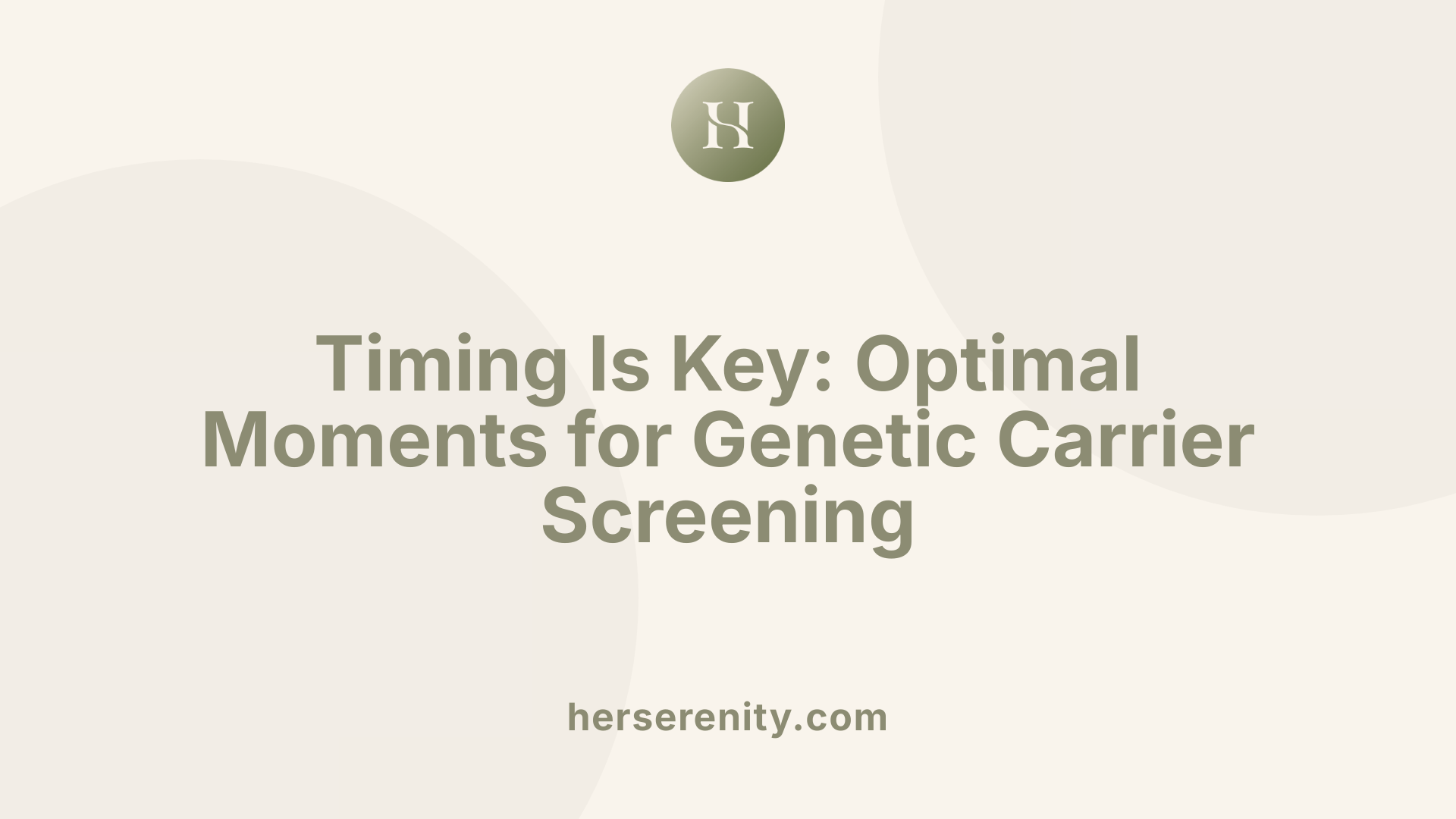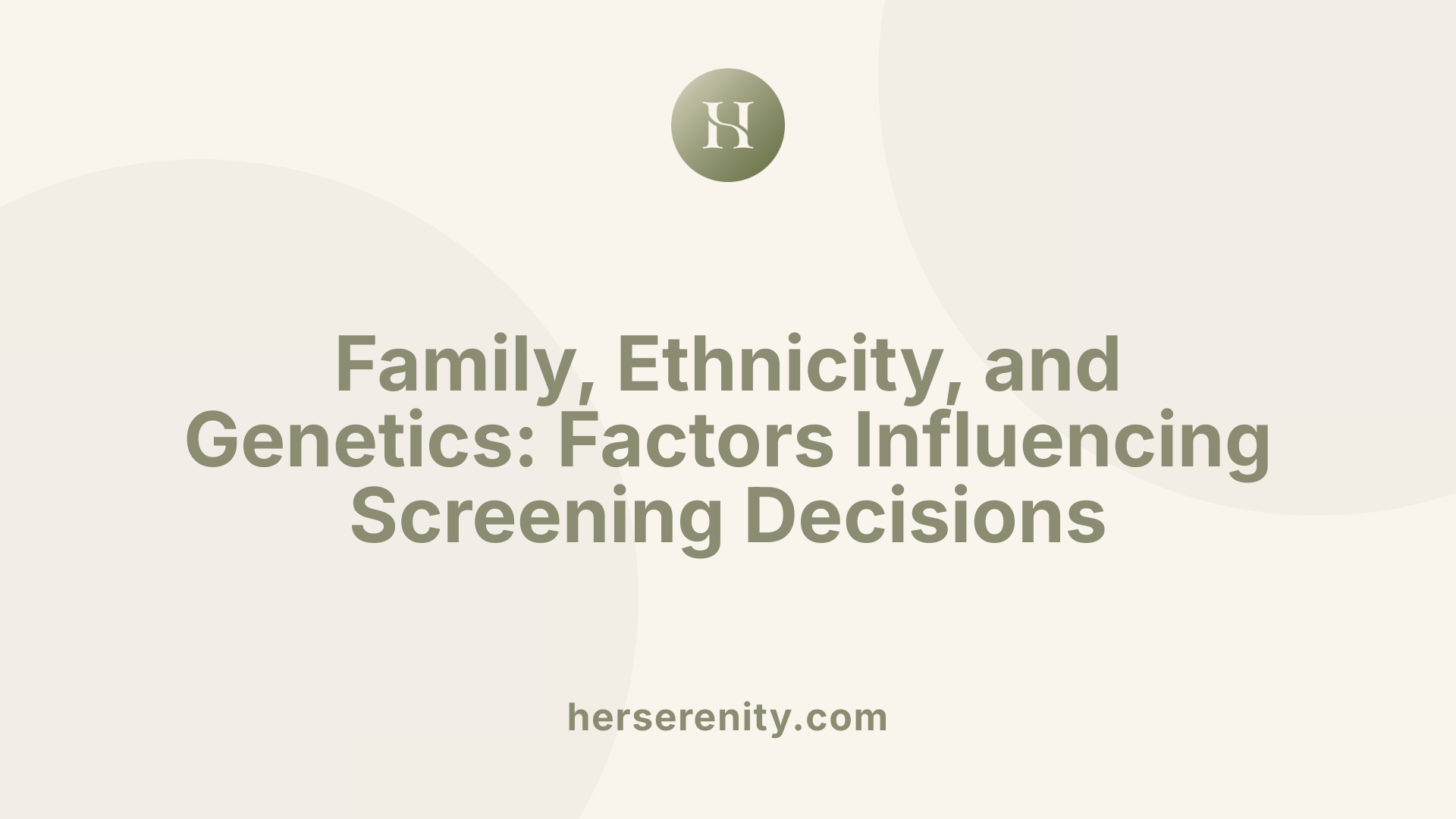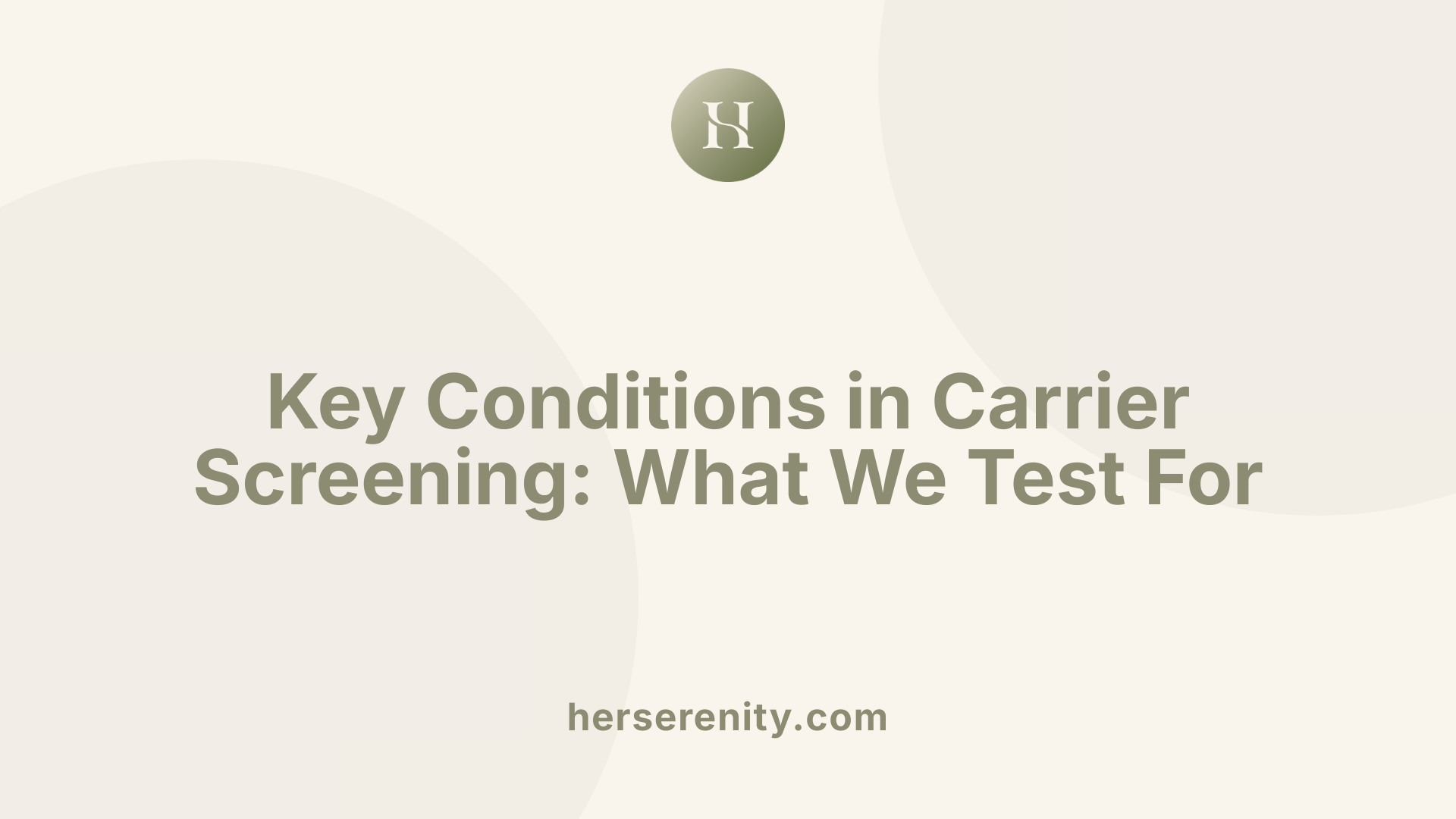When to consider genetic carrier screening before conception
Navigating Genetic Carrier Screening: Key Insights for Prospective Parents

Understanding the Importance of Genetic Carrier Screening Before Starting a Family
Genetic carrier screening is a proactive medical service designed to identify individuals who carry gene mutations that could lead to serious inherited conditions in their offspring. Offering this screening before conception empowers couples with the knowledge to make informed reproductive decisions and understand their potential risks. This article explores when and why genetic carrier screening should be considered, the role it plays in reproductive health, and its integration with other fertility treatments and options, guiding prospective parents through this essential step in family planning.
What is Genetic Carrier Screening and Why is it Essential Preconception?

Understanding Genetic Carrier Screening
Genetic carrier screening is a type of genetic test performed on individuals who themselves show no symptoms of a genetic disorder but may carry gene mutations that can be passed to their children. These mutations typically relate to autosomal recessive or X-linked recessive conditions—which means a child must inherit mutated copies of a gene from both parents (autosomal recessive) or carry a mutated gene on the X chromosome (X-linked recessive) to be affected.
Autosomal and X-linked Recessive Inheritance Explained
In autosomal recessive disorders, a child inherits one mutated gene from each parent, resulting in a 25% chance of the child being affected. For X-linked recessive conditions, which usually affect males more severely, a mother who is a carrier can pass the mutation to her son, who may then manifest the disease.
Why Screening Before Pregnancy Matters
Offering carrier screening before pregnancy is highly recommended because it allows couples ample time to understand their genetic risks. Early knowledge facilitates comprehensive genetic counseling. Couples can then explore a range of reproductive options such as prenatal diagnosis, in vitro fertilization with preimplantation genetic testing, or use of donor gametes. This timing helps avoid rushed decisions during pregnancy and supports informed, thoughtful family planning.
Informing Reproductive Decision-Making
Carrier screening provides critical information about the likelihood of having an affected child. Armed with these results, prospective parents can make empowered choices that align with their values and circumstances. Whether to proceed naturally, seek assisted reproductive technologies, or consider adoption, these decisions stem from clear insights into genetic risks.
By offering genetic carrier screening ideally before conception, healthcare providers enable couples to anticipate and manage inherited genetic risks effectively, fostering healthier future generations.
When Should Genetic Carrier Screening be Offered? Ideal Timing and Situations

When is the best time to consider genetic carrier screening?
Genetic carrier screening is ideally offered before pregnancy begins. This preconception timing allows individuals and couples sufficient time to receive genetic counseling, understand their results, explore reproductive options, and make informed decisions without urgency.
Recommendations for offering screening preconception or early pregnancy
Professional guidelines strongly recommend offering reproductive genetic carrier screening to all women planning a pregnancy or in early pregnancy. While preconception screening is preferred, testing can also be done early in pregnancy if preconception screening was not performed.
Benefits of preconception screening timing
Screening before conception supports a less stressful and more comprehensive counseling experience. It provides opportunities for advanced reproductive choices such as in vitro fertilization with preimplantation genetic testing, donor gametes, or prenatal diagnosis with possible pregnancy management options. Early screening during pregnancy can lead to complex and time-sensitive counseling challenges.
Situations warranting screening, such as family history, ethnicity, consanguinity
Screening is especially important for individuals with a personal or family history of genetic disorders, those belonging to high-risk ethnic populations (e.g., Ashkenazi Jewish, African, Mediterranean, Middle Eastern, Southeast Asian descent), and consanguineous couples. These factors increase the likelihood of being a carrier for certain inherited conditions and guide more targeted screening.
Screening of reproductive partners
If an individual is identified as a carrier, their reproductive partner should be offered testing to clarify combined risk. Concurrent screening of both partners is advisable when time constraints exist to expedite decision-making. When both partners carry mutations in the same gene, genetic counseling and discussion of reproductive options are essential.
By adhering to these recommendations, genetic carrier screening can effectively inform reproductive planning and improve outcomes for families.
Influence of Family History, Ethnicity, and Consanguinity on Carrier Screening

How do family history, ethnicity, and consanguinity affect the decision to undergo carrier screening?
Family history, ethnicity, and consanguinity are crucial factors that influence the decision to undergo genetic carrier screening. A positive family history of genetic disorders raises the likelihood of carrying the same gene mutations, prompting screening to better assess reproductive risks.
Certain ethnic groups have higher prevalence rates for specific inherited conditions. For instance, individuals of Ashkenazi Jewish descent face increased risks for disorders like Tay–Sachs disease, familial dysautonomia, and Canavan disease. Similarly, people of African, Mediterranean, Middle Eastern, Southeast Asian, or West Indian ancestry are more likely to carry hemoglobinopathies such as sickle cell disease or thalassemia.
Consanguinity, or close genetic relatedness between partners, elevates the risk of autosomal recessive conditions by increasing the chance that both partners carry the same pathogenic variant inherited from a common ancestor. This makes expanded and targeted carrier screening especially important in such cases.
Carrier screening informed by these factors enables personalized reproductive risk assessment and guides couples in making informed choices, such as pursuing further genetic counseling, prenatal diagnosis, or assisted reproductive technologies.
| Factor | Examples of Increased Risks | Implications for Screening |
|---|---|---|
| Family History | Presence of inherited disorders in relatives | Prioritize comprehensive screening and counseling |
| Ethnicity | Ashkenazi Jewish (Tay–Sachs, Canavan) | Ethnicity-specific panels including relevant disorders |
| African, Mediterranean descents (hemoglobinopathies) | Include specific testing such as hemoglobin electrophoresis | |
| Consanguinity | Related partners increasing recessive disorder risk | Recommend expanded carrier screening to detect shared mutations |
Understanding these influences ensures carrier screening is both efficient and effective in detecting the potential risk of inheriting severe genetic conditions.
Common Genetic Conditions Screened in Carrier Testing

What are the common genetic conditions included in carrier screening panels?
Carrier screening typically focuses on several well-known genetic conditions that pose significant risks to offspring. The most frequently included disorders are cystic fibrosis (CF), spinal muscular atrophy (SMA), fragile X syndrome, and hemoglobinopathies. These conditions are inherited in autosomal recessive or X-linked patterns and are notable for their impact on health and prevalence in specific populations.
Overview of conditions: cystic fibrosis, spinal muscular atrophy, fragile X syndrome, hemoglobinopathies
- Cystic Fibrosis (CF): An autosomal recessive disorder caused by mutations in the CFTR gene resulting in thick, sticky mucus affecting lungs and digestive system. Screening panels include analysis of at least the 23 most common CFTR mutations.
- Spinal Muscular Atrophy (SMA): An autosomal recessive neuromuscular disorder caused by deletions in the SMN1 gene. Screening uses molecular tests specifically detecting SMN1 gene deletions.
- Fragile X Syndrome: An X-linked disorder caused by premutation or full mutation expansions in the FMR1 gene. Carrier screening is recommended especially for women with family history or when planning pregnancy.
- Hemoglobinopathies: Conditions such as sickle cell disease and thalassemia. Risk assessment involves complete blood counts, red blood cell indices, and hemoglobin electrophoresis. Particular attention is given to individuals of African, Mediterranean, Middle Eastern, Southeast Asian, or West Indian descent.
Inheritance patterns and prevalence
Most of these disorders are inherited in an autosomal recessive manner, meaning both parents must be carriers for the child to be affected. Fragile X is X-linked, affecting mostly males. Prevalence varies by ethnic background: for example, Tay–Sachs and familial dysautonomia are more common in Ashkenazi Jewish populations, while sickle cell disease is frequent in individuals of African descent.
Screening methods for each
Testing typically involves blood or saliva samples. Molecular techniques include mutation panels for CF, SMN1 deletion testing for SMA, and expanded gene analysis for hemoglobinopathies. Fragile X screening detects premutation carriers through genetic analysis of FMR1.
Implications of positive results
Being identified as a carrier indicates a risk of passing the condition to offspring. If both reproductive partners are carriers for the same disorder, there is a 25% chance their child will be affected for autosomal recessive conditions. This necessitates genetic counseling to discuss reproductive options such as prenatal diagnosis or assisted reproductive technologies. Positive findings also have implications for extended family members who may carry the same mutations.
Expanded Carrier Screening: Advancements and Challenges

What is expanded carrier screening and how does it differ from traditional panels?
Expanded carrier screening (ECS) is a comprehensive genetic test that screens hundreds to thousands of genes simultaneously to identify carriers of pathogenic variants associated with numerous autosomal recessive and X-linked conditions. Unlike traditional carrier panels, which usually focus on a limited number of genes based on ethnic background or family history, ECS employs advanced genomic sequencing technologies such as next-generation sequencing to analyze a wide spectrum of genetic disorders in a single test.
Technological advances enabling broad gene panels
Technological progress in genomic sequencing has made it possible to move from targeted gene panels to large-scale, population-wide screening. ECS leverages these advancements to provide a more inclusive approach, uncovering risks for many conditions that may not be relevant to a person's ethnicity or known family history. This expansion increases the detection rate of carrier status, offering couples a more comprehensive picture of their reproductive risks.
Advantages of ECS for comprehensive risk assessment
By screening for multiple conditions simultaneously, ECS can identify couples at increased risk of having affected children more effectively than traditional methods. This broadened scope facilitates greater reproductive autonomy, allowing prospective parents to consider options such as prenatal diagnosis, in vitro fertilization with preimplantation genetic testing, or use of donor gametes. ECS is particularly recommended for all couples planning a pregnancy, including those with consanguinity or subfertility.
Increased complexity in genetic counseling
The extensive data generated by ECS increases the complexity of genetic counseling. Counselors must interpret a broad range of findings, including pathogenic and likely pathogenic variants, while excluding variants of uncertain significance to prevent confusion. This complexity requires significant expertise and time, which can be challenging given the limited availability of genetic counseling resources.
Implementation barriers and resource needs
Despite its advantages, the implementation of ECS faces several barriers. These include the high cost of testing, fragmentation of resources, lack of awareness among healthcare providers and patients, and the absence of standardized guidelines. To address these challenges, multidisciplinary approaches involving genetic healthcare professionals are recommended to develop educational materials, standardize practices, and ensure equitable access to high-quality ECS services.
| Aspect | Description | Implication |
|---|---|---|
| Definition of ECS | Testing for hundreds to thousands of genes simultaneously | Broader assessment beyond ethnicity-based panels |
| Technological Advances | Use of next-generation sequencing and advanced genomics | Enables comprehensive, population-wide screening |
| Advantages | Higher detection rates; informed reproductive choices | Expanded reproductive options and personalized planning |
| Counseling Complexity | Need for interpretation of extensive genetic data; exclusion of uncertain variants | Requires skilled counselors and increased resource allocation |
| Implementation Challenges | Cost, awareness gaps, lack of standardized policies | Necessitates multidisciplinary efforts and policy development |
Genetic Counseling: Essential Support in Reproductive Carrier Screening
Why is genetic counseling important in the process of carrier screening?
Genetic counseling plays a critical role in reproductive carrier screening by offering individuals and couples detailed insights into their screening results, explaining the risks of passing on genetic conditions, and outlining available reproductive options. This support is vital to ensure informed decision-making, as receiving information about carrier status can raise complex emotional and psychosocial concerns.
When should genetic counseling be offered during carrier screening?
Ideally, genetic counseling should be provided before or at the time of reproductive carrier screening, particularly during the preconception period. This timing allows ample opportunity to understand test implications and consider reproductive choices fully. Early pregnancy counseling may be necessary if screening occurs later, requiring efficient, time-sensitive discussions.
How is counseling managed after positive carrier results?
If an individual is identified as a carrier, counseling focuses on explaining inheritance patterns, the likelihood of both partners being carriers, and potential next steps such as partner testing. Couples found to be carriers for the same condition receive tailored counseling to discuss options like prenatal diagnosis, assisted reproductive technologies, or alternative family-building methods.
What strategies address the shortage of genetic counselors?
The growing demand for reproductive genetic screening has outpaced the availability of counseling professionals. To mitigate this, many programs employ alternative methods such as detailed written materials, instructional videos, and telehealth consultations. These tools ensure consistent information delivery and improve access to counseling support, especially in large-scale screening initiatives.
How do telehealth and educational resources support counseling?
Telehealth platforms enable remote counseling sessions, enhancing convenience and reach while maintaining personalized care. Supplementary educational resources help prepare individuals for consultations and reinforce understanding post-session. This blended approach balances the need for individualized attention with scalability across diverse populations.
Reproductive Options after Carrier Screening: Planning Ahead
What reproductive options are available for couples found to be carriers?
Couples identified as carriers of the same genetic condition have several reproductive options to consider, as they face a 25% chance of passing the disorder to their child if it is an autosomal recessive condition.
Prenatal diagnosis and pregnancy management
One option is prenatal diagnostic testing, which can be performed during pregnancy to determine if the fetus is affected. This may involve procedures like chorionic villus sampling or amniocentesis. If the fetus is found to have the condition, some couples may choose pregnancy termination depending on personal, ethical, or cultural beliefs.
Assisted reproductive technologies and IVF with preimplantation genetic testing
Assisted reproductive technologies (ART) provide alternatives that allow couples to avoid passing on the genetic disorder. In vitro fertilization (IVF) combined with preimplantation genetic testing (PGT) can screen embryos for the specific genetic mutation before implantation, enabling selection of unaffected embryos for pregnancy.
Alternative family building options
For couples who prefer not to use IVF or prenatal diagnosis, donor gametes (sperm or eggs) offer a way to have a child without the genetic risk. Adoption is another pathway to parenthood without genetic risks from both parents.
Acceptance of reproductive risk
Some couples may opt to conceive naturally and accept the 25% risk of having a child with the genetic condition, making informed decisions based on their values and circumstances.
Genetic counseling is essential throughout this decision-making process to provide information, support, and guidance tailored to each couple’s needs and preferences.
Integrating Genetic Carrier Screening with Other Fertility Treatments
How does genetic carrier screening fit into the broader context of fertility treatments?
Genetic carrier screening is an essential component in the reproductive planning process, especially when fertility treatments are involved. It identifies individuals or couples carrying genetic mutations that could lead to inherited disorders in offspring. This knowledge enables tailored medical care and informed decision-making during fertility interventions.
Overview of common fertility treatments: medications, surgery, ART
Fertility treatments range from medications that stimulate ovulation, surgical procedures to correct anatomical problems, to assisted reproductive technologies (ART), such as in vitro fertilization (IVF). ART involves fertilizing eggs outside the body and transferring embryos back to the uterus.
How carrier screening complements assisted reproductive technologies
Carrier screening integrated with ART enhances reproductive safety by enabling genetic testing of embryos before implantation. This approach reduces the risk of passing on recessive or X-linked genetic conditions. Couples identified as carriers may opt for IVF combined with preimplantation genetic testing (PGT) to select unaffected embryos.
Timing considerations in fertility treatments and genetic screening
Offering carrier screening preconceptionally or early in the fertility treatment plan is optimal. Early screening provides ample time for genetic counseling and discussion of reproductive options, including ART with genetic testing or other alternatives. If screening is delayed until after treatment initiation, options become time-sensitive and more complex.
Examples of using IVF with genetic testing
For example, if both partners are carriers for cystic fibrosis or spinal muscular atrophy, IVF with PGT can screen embryos to avoid implantation of affected embryos. This strategy improves chances of a healthy pregnancy and reduces the likelihood of genetic disease transmission.
Carrier screening thus complements and enhances the success and safety of fertility treatments by informing reproductive risk and guiding personalized planning.
Understanding Assisted Reproductive Technologies (ART)
What are assisted reproductive technologies and how do they aid conception?
Assisted Reproductive Technologies (ART) refer to medical procedures used to help individuals or couples conceive when they face difficulties with natural fertility. ART involves handling eggs and sperm outside the body to facilitate fertilization, leading to pregnancy that might otherwise be challenging or impossible.
Definition and examples: IVF, ICSI, IUI
Common examples of ART include:
- In Vitro Fertilization (IVF): Eggs are retrieved from the ovaries and fertilized by sperm in a laboratory dish. The resulting embryos are then transferred back into the uterus.
- Intracytoplasmic Sperm Injection (ICSI): A single sperm is injected directly into an egg to increase fertilization chances, often used in cases of male infertility.
- Intrauterine Insemination (IUI): Prepared sperm is directly inserted into the uterus around the time of ovulation to enhance the chance of fertilization.
Differences between ART and other fertility treatments
Unlike fertility medications or surgeries that enhance natural conception, ART physically manipulates gametes and embryos outside the body. This allows greater control over fertilization and embryo development stages. ART procedures can also incorporate genetic testing of embryos before implantation.
Role of ART in overcoming infertility causes
ART helps address a variety of infertility causes:
- Ovulatory dysfunction
- Tubal blockages or damage
- Male factor infertility like low sperm count or motility
- Unexplained infertility when other treatments have failed
Use of ART in conjunction with genetic screening
When individuals or couples identified as carriers of genetic disorders undergo ART, it provides an opportunity to perform genetic screening on embryos before implantation. This helps in selecting embryos free from specific inherited conditions, aiding in informed reproductive decisions and reducing the risk of transmitting genetic diseases.
Common Causes of Infertility Addressed by Medical Treatments
What are the typical causes of infertility that medical treatments address?
Infertility can arise due to a variety of female and male factors. In women, the primary causes include ovulation disorders such as polycystic ovary syndrome (PCOS), tubal blockages that prevent egg fertilization, and endometriosis, which can impair reproductive function.
Male factors often involve issues with sperm quality, including low sperm count, poor sperm motility (movement), abnormal sperm morphology (shape), and conditions like varicocele, which is an enlargement of veins within the scrotum that can affect sperm production.
How do treatments target each cause?
Treatment strategies are tailored to address the underlying issue:
- Ovulation disorders: Medications such as clomiphene citrate or letrozole stimulate the ovaries to promote ovulation.
- Tubal blockages and endometriosis: Surgical interventions can remove blockages or lesions to restore fertility.
- Male factor issues: Varicocele repair surgery can improve sperm quality, while cases with low sperm count or motility may benefit from assisted reproductive technologies (ART).
Surgical and medication roles in treatment
Surgery plays a significant role in correcting physical causes of infertility, such as repairing blocked fallopian tubes or excising endometrial tissue in endometriosis. Medications primarily focus on hormonal regulation to induce ovulation but can also be used to manage underlying conditions impacting fertility.
In some cases, when conventional treatments are insufficient, assisted reproductive technologies such as in vitro fertilization (IVF) are employed to achieve pregnancy.
This combination of medical and surgical approaches offers a comprehensive pathway to address the most common causes of infertility, enhancing the chances of successful conception.
Fertility Medications: Mechanisms and Applications
Types of Fertility Medications
Fertility medications include several types designed to address various reproductive challenges. Common medications are:
- Clomiphene citrate: Stimulates ovulation by blocking estrogen receptors in the brain, leading to increased release of follicle-stimulating hormone (FSH) and luteinizing hormone (LH).
- Gonadotropins: Injectable hormones such as FSH and LH directly stimulate the ovaries to produce multiple follicles.
- Metformin: Used mainly in women with polycystic ovary syndrome (PCOS), this medication improves insulin resistance which can normalize ovulation.
- Bromocriptine: Treats high prolactin levels that can inhibit ovulation by decreasing prolactin secretion from the pituitary gland.
Hormonal Regulation and Ovulation Induction
These medications regulate or stimulate hormonal pathways critical for ovulation and fertility. Clomiphene acts on the hypothalamus and pituitary gland to induce ovulation indirectly by altering estrogen feedback. Gonadotropins provide direct ovarian stimulation, increasing follicle growth and ovulation rate.
Metformin helps correct metabolic imbalances in PCOS patients, restoring regular ovulation cycles. Bromocriptine reduces elevated prolactin that may cause anovulation, allowing normal menstrual cycles to resume.
Clinical Applications
- Ovulation induction: Clomiphene and gonadotropins are primary treatments for women who do not ovulate regularly.
- Polycystic ovary syndrome: Metformin is often combined with fertility agents to improve ovulation.
- Hyperprolactinemia: Bromocriptine treats infertility related to high prolactin hormone levels.
Supporting Male Fertility
Some medications also support male fertility by improving sperm quality. For example, certain hormonal treatments can optimize testosterone levels and enhance sperm production when hormonal imbalances are identified.
Overall, fertility medications are tailored to individual hormonal profiles and reproductive goals, making them essential tools in managing infertility.
Surgical Interventions to Improve Fertility and Conception
Are there any surgical options to improve fertility and conception?
Yes, there are several surgical procedures designed to enhance fertility by addressing physical issues that can impair conception.
Procedures for correcting blocked fallopian tubes, removing fibroids or endometrial lesions
Surgery can open blocked fallopian tubes, enabling the egg and sperm to meet naturally. Removal of uterine fibroids, especially those distorting the uterine cavity, can improve implantation rates. Likewise, endometrial lesions caused by endometriosis can be excised or ablated to restore normal pelvic anatomy and function, which may increase chances of pregnancy.
Male surgeries like vasectomy reversal and varicocelectomy
On the male side, procedures such as vasectomy reversal restore the passage of sperm, while varicocelectomy repairs dilated veins in the scrotum (varicoceles) that can impair sperm production and quality, thus boosting fertility potential.
Minimally invasive techniques: laparoscopy, hysteroscopy
These interventions often use minimally invasive approaches. Laparoscopy allows visualization and treatment of pelvic issues like adhesions or endometriosis with small incisions, leading to shorter recovery. Hysteroscopy provides access to the uterine cavity to remove polyps, fibroids, or septums.
When surgery is preferred over or combined with ART
Surgery may be preferred when correctable anatomical problems are identified. It is also commonly combined with assisted reproductive technologies (ART) such as in vitro fertilization (IVF) to improve overall success rates by optimizing the reproductive environment before or during ART cycles.
Together, these surgical options support individuals and couples in overcoming infertility related to structural issues, increasing their likelihood of achieving a successful pregnancy.
Intrauterine Insemination (IUI): Role and Effectiveness
Procedure overview and indications
Intrauterine insemination (IUI) is a fertility treatment that involves placing washed sperm directly into a woman's uterus around the time of ovulation. The purpose is to increase the number of sperm that reach the fallopian tubes, thereby improving the chances of fertilization. IUI is commonly used to address mild male factor infertility, cervical issues that hinder sperm passage, and unexplained infertility.
Use alongside fertility medications
Often, IUI is combined with fertility medications that stimulate ovulation, such as clomiphene citrate or gonadotropins. These drugs enhance the number of mature eggs released during a cycle, further increasing the possibility of conception when used alongside sperm placement.
Success rates and risks
Success rates for IUI vary but can reach up to 20% per cycle depending on factors like age and underlying fertility issues. While it is less invasive than other assisted reproductive technologies, IUI does carry some risks, including the potential for multiple pregnancies (twins or more) due to stimulated ovulation, as well as a slight risk of infection.
Position in treatment hierarchy before advanced ART
IUI is often considered an initial treatment option before proceeding to more advanced assisted reproductive technologies (ART) such as in vitro fertilization (IVF). It is favored for its relative simplicity, lower cost, and less invasive nature, making it a practical step in managing certain infertility cases.
Empowering Reproductive Choices with Genetic Carrier Screening
Genetic carrier screening represents a vital tool for individuals and couples planning to start a family, providing insights into risks for inherited genetic disorders and shaping reproductive decisions. When offered ideally before conception, it allows comprehensive genetic counseling and consideration of options like prenatal diagnosis or assisted reproductive technologies. Complementing fertility treatments and surgical interventions, carrier screening enhances personalized reproductive healthcare. As genomic technologies evolve and screening becomes more accessible, integrating multidisciplinary support and educational resources remains crucial to empower prospective parents with knowledge and choices, ultimately promoting healthier generations ahead.
References
- Carrier Screening for Genetic Conditions
- Genetic Counselling Needs for Reproductive ...
- Reproductive carrier screening
- Carrier Testing Panels for Genetic Diseases
- Carrier screening and pregnancy
- Preconception genetic testing: A guide to informed family ...
- Treatment for infertility
- Fertility drugs
- Fertility Treatments For Infertility
- Infertility: Types, Causes, Symptoms, Diagnosis & Treatment


































































































